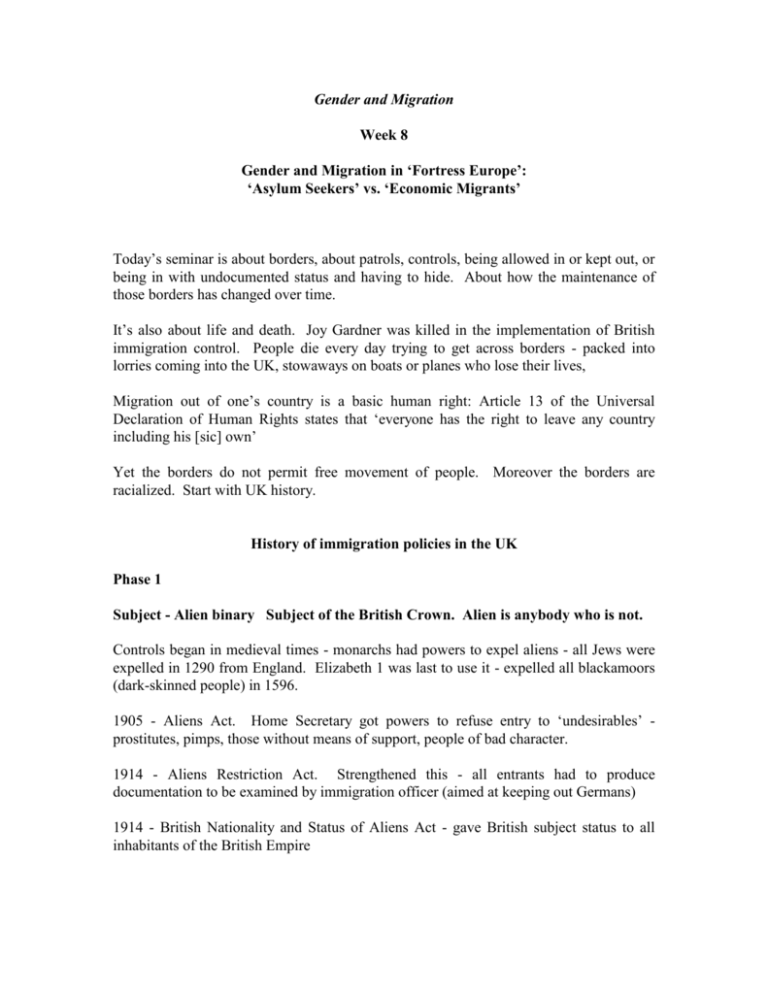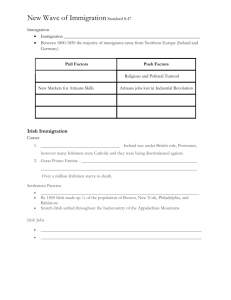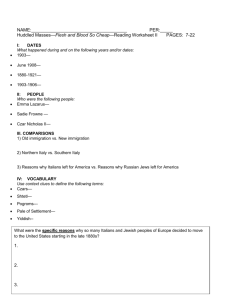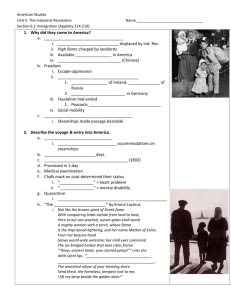
Gender and Migration
Week 8
Gender and Migration in ‘Fortress Europe’:
‘Asylum Seekers’ vs. ‘Economic Migrants’
Today’s seminar is about borders, about patrols, controls, being allowed in or kept out, or
being in with undocumented status and having to hide. About how the maintenance of
those borders has changed over time.
It’s also about life and death. Joy Gardner was killed in the implementation of British
immigration control. People die every day trying to get across borders - packed into
lorries coming into the UK, stowaways on boats or planes who lose their lives,
Migration out of one’s country is a basic human right: Article 13 of the Universal
Declaration of Human Rights states that ‘everyone has the right to leave any country
including his [sic] own’
Yet the borders do not permit free movement of people. Moreover the borders are
racialized. Start with UK history.
History of immigration policies in the UK
Phase 1
Subject - Alien binary Subject of the British Crown. Alien is anybody who is not.
Controls began in medieval times - monarchs had powers to expel aliens - all Jews were
expelled in 1290 from England. Elizabeth 1 was last to use it - expelled all blackamoors
(dark-skinned people) in 1596.
1905 - Aliens Act. Home Secretary got powers to refuse entry to ‘undesirables’ prostitutes, pimps, those without means of support, people of bad character.
1914 - Aliens Restriction Act. Strengthened this - all entrants had to produce
documentation to be examined by immigration officer (aimed at keeping out Germans)
1914 - British Nationality and Status of Aliens Act - gave British subject status to all
inhabitants of the British Empire
1920 - Act gave immigration officers right to refuse leave to land to those with no means
of support, seeking unauthorized emp, mentally unfit, those convicted of serious crimes
abroad. Through 1930s, anti-semitism was rife.
Renewed annually until WW2.
Phase 2
Citizen-Foreigner? Citizen of the UK and Colonies.
not.
Foreigner= anybody who is
1948 British Nationality Act
Labour shortage after WW2. Unlimited Irish immigration. Poles, Ukrainians, Latvians
from displaced persons camps in Germany (European Voluntary Workers Scheme).
Polish forces in UK encouraged to stay. At first dependants could come but after 1948
only single people. As shortages contined, recruitment from colonies began. Can see that
Europeans were preferred over ‘blacks’.
Many of those coming from Africa, Asia, Far East, Cyprus, Caribbean were UK citizens
with rights to live and work in UK. Restrictions, eg on those from Cyprus, were illegally
imposed by colonial govts.
1962 - Commonwealth Immigrants Bill made vouchers necessary for entry unless were
UK or born or holder of UK passport issued by British government or High
Commissioner. First UK based restriction on those coming from Commonwealth
countries. Category A voucher if had job to go to, B if had skills in short supply, C for
others to be dealt with in order, war service giving priority. Cat C abolished 1965. Here
we see the process of transforming citizens into migrants workers. Those born in Ireland
exempt. Primarily designed to restrict New Commonwealth immigration, as more and
more such countries became independent, but also affected Old Commonwealth. East
African Asians who chose to retain citizenship of UK and Colonies generally exempt as
were issued passports by British govt via representatives.
1968 Commonwealth Immigrants Act - controlled entry of British passport holders
without close connection to UK (not born here, no parents or grandparents who were UK
citizens). Primarily designed to deprive British Asians of their right of entry to the only
country they were citizens.
Phase 3
Patrial - non-patrial
Patrial = those not subject to UK immigration control (UK citizen by birth, naturalisation
or registration; Commonwealth citizen with parent born in UK; Commonwealth women
married to men born in UK before 1983). Non-Patrial = those who are subject to UK
immigration control.
1971 Immigration Act - Bill controlling entry of all those except having birth or descent
connection. Work permits replaced vouchers and didn’t carry permanent residence rights
or entry for dependants until 1975. Basis of today’s immigration controls. Not about
subjects and aliens but patrials - right of abode in UK - and non-patrials. Worked to keep
black people out of Britain but free things up for Australians and Canadians - mainly
white - as they could often claim descent.
Potential for Commonwelath labour to be replaced by that from Europe - joined EC
1972 - Acceptance of most Asians fleeing Amin’s Uganda in 1972 seen as betrayal by
Enoch Powell et al and National Front.
1979 - Conservative Party manifesto vague on everything except immigration and
nationality.
1980 - Rules tightened re entry of husbands and fiances, elderly dependants, visitors or
students.
Phase 4
Citizen (3 types) and Non-Citizen
1981 British Nationality Act - eroded concept of a British subject to three types of
citizenship: British citizen (largely white) with right of abode (able to enter UK freely at
any time); citizen of dependant territories & British overseas citizen (largely black).
British citizens qualify by birth, parent or grandparent born in UK, registered or
naturalised, settled and lived in UK for 5 years before 1983.
British Dependent Territories Citizens - born in or had parent born in British colony
(Gibraltar and Falkland Islanders can get full British citizenship)
British Overseas citizen - largely Asians in East Africa
1987 - Fines introduced for those bringing immigrants in without proper documentation
(airlines)
1988 - Absolute right of men settled before 1973 to brings families repealed - didn’t give
to women, challenged, so repealed all.
The racialized discourse of such controls, such policing of borders, has shifted from overt
to covert. For example, the concept of the economic migrant (as contrasted with the
asylum seeker) can be seen as a conceptual move that retains control but helps to
maintain the rhetoric that the UK is a fair, just, humanitarian state that upholds its
international responsibilities. Those with ‘real’ claims are let in, but, of course,
‘imposters’ are kept out. As Razack puts it, ‘the language of control is masked by the
language of humanitarian values and economic rationalism’ (p. 60). Firm but fair, in the
interests of ‘race’ relations (to keep non-white immigrants out) - Enoch Powell - in the
interests of ‘real’ refugees to keep ‘bogus’ ones out because then the ‘real’ ones would
have their applications processed more quickly.
Let’s think about why economic migrants are considered illegitimate? Why is that K can
move freely in a globalized world but not L? Imagine it the other way around.
Covert racism can be discerned in media coverage of immigration to Europe, that fuels
stereotypes and inaccuracies. Many of these have hegemonic status among white British,
for example.
Appeals to working class interests re employment, idea of foreigners stealing jobs.
Racism:-
‘influx’, ‘waves’, ‘swamping’ of culture and genes
in fact, emigration exceeded immigration, expats abroad maintain culture
well
Stealing jobs
brought in as cheap labour - encouraged, recruited even.
Have no claims - Windward example, colonies. We’re over here because
you were over there.
Fortress Europe
Schengen Group (Belgium Neth, Lux, France, W. Germany) formed in 1985 seeking
common policies and restrictions. Divisions within Europe - North, South.
Eurocentrism: European superiority and domination over South
giving way to
Europism:
defensive construction of a ‘pure Europe’ cleansed of foreign and
‘uncivilised’ elements. Welfare chauvenism: defending welfare state against greedy
‘outsiders’
Gendered Assumptions
Gendered dimensions of controls: men constructed as breadwinners, dependants assumed
to be women and children depending on men. Following the 1962 Act, male migrants
workers could bring dependents but female could not. Having a British born father gave
exemption from deportation where a British born mother did not. Being the wife of a
man exempt meant the woman was exempt, being the husband of a woman who was
exempt did not.
Assuming man is head of family, breadwinner, decision maker. Yet there’s been a long
history of women coming to work. Assumed men coming in as dependants would look
for jobs, women would not.
Same has applied until very recently to students. When challenged successfully in
European courts, automatic right was withdrawn from men to ‘even’ things up. Levelling
down.
Women with no time limit on her right to remain had no automatic right to have her
husband in UK - at immigration officer’s discretion. Men in that situation had automatic
rights to bring foreign wives. Women not able to pass on their citizenship to children
born abroad. Under 1968 Act, British woman citizen married to non-British man could
not enter UK.
Marriage has become the backbone of legal entrance to the EU - family reunification or
formation one of few legal ways of entering Europe. Most women come in as legal
dependent spouse. May be tested (Film Green Card). Tests based on romantic love eurocentric. Virginity test instituted in 1978 on Asian brides - abolished after
international outrage. Britain has DNA tests for children. Nuclear family conception social parenthood, care by grandparents not accepted. Male bread-winner principle.
Before wife gets own right to stay (1-5 years) very vulnerable - marriage problems, death
of husband. Cannot apply for paid work.
Gendered Experiences of Immigration:
Labour mkt opportunities poor - even narrow range of occupations than women as a
whole: domestic service, catering, clothing. High UE, wage gap compared with white
women workers. Often outside formal regulation. First victims of restructuring. Also
sex work: estimated that 40% of Thai women in Britain are sex workers - lured by
promises of waitressing or marriage. Imprisioned in brothels - can’t complain as illegals.
Poorer access to welfare provision.
BUT women often feel the racism more than the patriarchy.
Gender persecution not recognised as grounds for asylum. Women may be persecuted
for what they do - child outside marriage, sexual relationship outside marriage, espouse
women’s rights/ feminism - as well as what they don’t do - failure to uphold religious
practices, refusal to marry - as well as for what is done to them - domestic violence, rape.
In March 1993 gender persecution guideliness were introduced under Canada’s
Immigration Act (article by Razack). Razack sees these as a major and remarkable
achievement. Resulted from intensive lobbying by feminists. Who can make a case?
- women fleeing severely abusive spouses who can show origin country can’t or
won’t protect them
- women encountering severe state sanctioned discrimination
Problems:
Gender has not been added as an explicit ground - guidelines through
which gender based claims can be linked to other grounds, eg. persecution on the grounds
of political opinion (a woman in an Islamic country not observing Islamic practices).
Problems with the trauma of disclosure, evidence, cross-examination, officials not having
or acquiring sufficient knowledge of the country involved and social relations within it to
judge whether internal flight is a possibility.
Razack importantly raises wider concerns about the discourse of gender persecution.
‘gender persecution, as it is deployed in refugee discourse, can function as a deeply
racialized concept in that it requires that Third World women speak of their realities of
sexual violence at the expense of their realities as colonized peoples’ (p. 48). ‘Success’
depends on being cast as cultural other. Suggests that Indian and continental African
women are more easily perceived as exotic victims than African Caribbean women mammies, matriarchs, criminals. As argued to be the case with survivors of sexual abuse,
need to be seen crying to be believed - helpless, despairing.
Just like the poem by Suneri - yes there are practices which violate women’s human
rights, but they can’t be understood outside processes of colonialism, global capitalism,
racism.
The practice of the guidelines can perpetuate the view of women fleeing the disorder of
the uncivilized, irrational, immoral ‘third world’ in the hope of entering the rational,
civilized, calm first world. Contributes to the construction and maintenance of a binary
between them. That binary is a condition of possibility for discourses of racialized
knowledge: the west knows refugees as other.
Razack argues that the analytical move in Western feminism that ultimately produces the
concept of gender persecution requires a universal woman, and a dehistoricized and
deterritorialized mapping. Akin to the women’s rights are human rights discourse. This
privileges gender inequalities, and requires western feminists to imagine Exotic Other
Females in need of western feminists’ protection, don’t have to engage with them as
subjects.
The Guidelines in Canada were publicly understood and supported as being about
rescuing oppressed, downtrodden women from, not poverty, or colonialism, or global
capitalism but third world men. Play to feelings of moral superiority from Canadians,
activated enduring racial stereotypes.
It might be considered ‘fighting sexism with
racism’, cited in Razack p. 72.
What about gender persecution in North? What about efforts and struggles to tackle it in
South? What about women whose experiences don’t easily fit into an imperial frame?
African Caribbean women esp.
Razack suggests new emphasis not on violence against women but violence by men, with
state responsibility for ways they support production of violent men. Need to change the
culture of male violence. The border controls need to work with respect, not pity. Look
at how the socio-economic situation constrains women, and see that linked to the North.
Assess her capacity not only to take internal flight but to survive economically and
emotionally. Detailed, contextualised approach.









